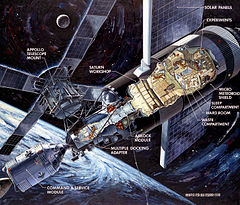Skylab

Skylab as photographed by its departing final crew (Skylab 4)
|
|

Skylab program insignia
|
|
| Station statistics | |
|---|---|
| COSPAR ID | 1973-027A |
| Call sign | Skylab |
| Crew | 3 per mission (9 total) |
| Launch | May 14, 1973 17:30:00 UTC |
| Launch pad | Kennedy Space Center LC-39A |
| Reentry | July 11, 1979 16:37:00 UTC near Perth, Australia |
| Mission status | Complete |
| Mass | 170,000 lb (77,111 kg)<http://history.nasa.gov/EP-107/ch4.htm> w/o Apollo CSM |
| Length | 82.4 feet (25.1 m) w/o Apollo CSM |
| Width | 55.8 feet (17.0 m) w/ one solar panel |
| Height | 36.3 feet (11.1 m) w/ telescope mount |
| Diameter | 21.67 feet (6.6 m) |
| Pressurised volume | 12,417 cu ft (351.6 m3) |
| Perigee | 269.7 mi (434.0 km) |
| Apogee | 274.6 mi (441.9 km) |
| Orbital inclination | 50° |
| Orbital period | 93.4 min |
| Orbits per day | 15.4 |
| Days in orbit | 2,249 days |
| Days occupied | 171 days |
| Number of orbits | 34,981 |
| Distance travelled | ~890,000,000 mi (1,400,000,000 km) |
| Statistics as of Re-entry July 11, 1979 | |
| Configuration | |

Skylab configuration as planned
|
|
Skylab was the United States' first space station, orbiting Earth from 1973 to 1979, when it fell back to Earth amid huge worldwide media attention. Launched and operated by NASA, Skylab included a workshop, a solar observatory, and other systems necessary for crew survival and scientific experiments. It was launched unmanned by a modified Saturn V rocket, with a weight of 170,000 pounds (77,111 kg). Lifting Skylab into low earth orbit was the final mission and launch of a Saturn V rocket (which was famous for carrying the manned Moon landing missions). Skylab was not simply a place of habitation; it was a place of massive science experiments for which when the bulk of data was returned, such as on films that had to be physically returned to Earth began the process of analyzing scientific and engineering data as each mission was completed. Skylab's solar observatory was one major aspect of study, and solar science was significantly advanced by the telescope; it observed the Sun as it never before. As Skylab finished up NASA's focus had shifted to development of the Space Shuttle, which had the promise of reducing the cost of space access compared to the previous launch systems
To transport astronauts to Skylab, there were a total of three manned expeditions to the station, conducted between May 1973 and February 1974. Each of these missions delivered a three-astronaut crew, carried in the Apollo Command/Service Module (Apollo CSM) launched atop the Saturn IB rocket, which is much smaller than the Saturn V. For the final two manned missions to Skylab, a backup Apollo CSM/Saturn IB was assembled and made ready in case an in-orbit rescue mission was needed, but this backup vehicle was never flown.
The station was damaged during launch when the micrometeoroid shield separated from the workshop and tore away, taking one of the main solar panel arrays with it and jamming the other main solar panel array so that it could not deploy. This deprived Skylab of most of its electrical power, and also removed protection from intense solar heating, threatening to make it unusable. However, the first crew was able to save Skylab by deploying a replacement heat shade and freeing the jammed solar panels, which was the first time a major repair was performed in space.
...
Wikipedia
